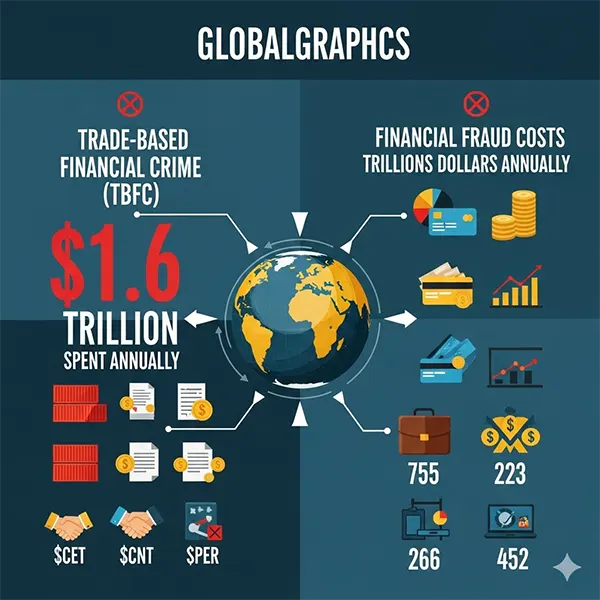As technology advances, the likelihood of social media and email exploitation increases.

Financial fraud continues to evolve and devastates victims, with scammers becoming increasingly sophisticated in their methods. According to the Federal Trade Commission (FTC), consumer losses to fraud were around 10 billion USD in 2023, marking the first time losses reached that benchmark. This was a 14% increase over 2022, with investment scams accounting for the highest reported loss at over 4.6 billion USD.
The psychological impact on victims often proves more devastating than the financial losses themselves, leading to shame, embarrassment, and profound loss of trust. Emotional manipulation and the desire for quick wins make it very easy for people to become victims of financial scams. Learning about them is extremely critical, so here we describe what you should know.
KEY TAKEAWAYS
- Financial fraud is a global problem.
- Be on the look out for urgent language, generic creating, and request for unusual payment methods quickly.
- If something feels off, trust your instincts immediately.
- Staying informed about common scam tactics and educating others is one of the most effective ways.
What Is Financial Fraud?
Financial fraud refers to any deliberate act intended to gain an unlawful financial advantage or deprive another person of their constitutional assets through deception or manipulation.
Scammers today use ever-more-advanced techniques to target people, companies, and financial institutions. They may trick people into sending money for fake emergencies, steal confidential information to commit identity theft, or create elaborate investment schemes promising unrealistic returns.
The motivations associated with financial fraud schemes typically involve quick profit, but the impact on victims extends far beyond monetary losses.
Technology has dramatically revolutionized fraud opportunities and methods. They allow criminals to conduct operations across geographic boundaries and target thousands of potential victims simultaneously. While digital payment systems offer new avenues for transferring stolen funds, social media platforms provide rich sources of personal information.
The psychological impact on fraud victims often illustrates more devastating than the financial losses themselves. Many victims experience embarrassment, shame, and a profound loss of trust that affects their willingness to engage in legitimate financial activities.
Financial Fraud Statistics
The scope of financial fraud in America reaches staggering proportions!
In the same year, consumers lost over $3.8 billion to investment scams, making them the most costly type of fraud that year. The amount reported in 2021 is double that amount. Imposter scams ranked second in estimated financial losses, totaling $2.6 billion in 2022—an increase from $2.4 billion in 2021.
GLOBAL FACT
An estimated $1.6 trillion is spent on trade-based financial crime (TBFC) alone each year, while financial fraud costs the world economy trillions of dollars every year.

Common Signs of Online Financial Fraud
There’s always an attribute that gives away online financial scams. Here’s what to take note of:
Email and Phishing Red Flags
Email remains one of the leading vectors for online financial fraud, with scammers sending millions of phishing messages that aim to steal login credentials and personal information. Since reputable businesses hardly ever invent time pressure for regular account maintenance, urgent language requesting quick action or threatening account closure is a serious red flag.
Generic greetings like “Dear Customer” instead of your actual name indicate centralized distribution emails rather than personalized communications from companies that know your account details. Suspicious sender addresses that don’t match legitimate company identities often contain subtle transcription errors or extra characters designed to fool casual inspection.
Links within emails pose significant complications when they don’t match the claimed destination, which you can independently confirm by hovering over them without clicking. Legitimate companies direct customers to their official websites, rather than unregistered domains or suspicious URLs that may contain malware or fake login pages.
Suspicious Website Indicators
Fake websites designed to steal financial information typically contain telltale signs that alert careful spectators to their fraudulent nature. URLs that don’t match official company websites or contain unusual characters should produce immediate suspicion, especially when they claim to represent well-known companies or government agencies.
Missing SSL certificates, indicated by the absence of “https://“ or a padlock icon in your browser, suggest that any private data you enter may be transmitted without encryption.
While legitimate websites usually require user-initiated actions before requesting sensitive data, excessively aggressive pop-ups that request personal information immediately upon visiting a website are a sign of possible fraud.
The absence of clear contact addresses or customer service details makes it impossible to verify the website’s legitimacy via independent channels.
Social Media and App-Based Fraud Sig
Scammers have turned social media sites into hunting grounds, taking advantage of users’ willingly provided personal information. Usually, unsolicited messages from unidentified contacts offering business partnerships or investment opportunities are the first steps in complex fraud schemes that aim to establish credibility before making a financial request.
Minimal personal information, fake profiles with limited photos, or recently created accounts often behave as covers for romance scams and pig butchering schemes. Before incorporating financial elements into their relationships with victims, these scammers spend weeks or months cultivating emotional ties.
Requests to move conversations to private messaging apps like WhatsApp or Telegram help scammers refrain from platform monitoring and create more intimate communication channels.
Common Signs of Offline Financial Fraud
There’s also offline financial fraud that’s important to be aware of, apart from online financial scams.
Phone Call Warning Signs
Phone-based fraud schemes remain exceptionally common, with scammers impersonating trusted officials. Callers claiming to represent government agencies who demand straight away payments are classic imposter scams, as real agencies communicate through official mail rather than surprise phone calls.
Threats of arrest, legal action, or account discontinuation designed to create panic and force immediate compliance serve as major red flags. Legitimate organizations provide written notice of serious complications and allow reasonable time for response, rather than creating artificial emergencies over the phone.
Requests for payment via wire transfers, gift cards, or cryptocurrency indicate fraud since legitimate businesses and agencies accept traditional payment methods. These unusual payment solicitations make funds difficult to trace and recover, which explains why scammers prefer them over conventional transactions.
Callers who possess some accurate personally identifiable information but request additional details may have obtained initial data via data breaches or social media research. However, legitimate groups working with your account information don’t need to verify basic details during routine communications.
Scammers Approaching Victims in Person
One common example is door-to-door fraud, where a scammer visits homes claiming to be a utility worker, charity fundraiser, bank representative, or government official. They may insist that immediate action is required, such as paying a “fee,” plying personal information, or signing a contract on the spot.
The personal presence allows scammers to utilize body language, tone, and appearance to build credibility and manipulate emotions like fear, sympathy, or urgency. For instance, a fraudster might claim there is a problem with your account or a tax issue that must be answered immediately, pressuring you to hand over cash, checks, or bank details.
Additionally, some pretend to be home repair or service providers, demanding upfront payment for subpar materials or work that is never finished. The face-to-face interaction makes it more difficult for victims to question the legitimacy of the request compared to an email or phone call.
Real-Life Examples of Financial Fraud
Major Fraud Cases
1. Bernie Madoff Ponzi Scheme
Bernie Madoff implemented the largest Ponzi scheme in history, defrauding investors of approximately $65 billion. Operating for decades, attracting wealthy individuals, Madoff promised consistent high returns, charities, and institutional investors.
Instead of legitimate investments, he used new stakeholder’ funds to pay returns to earlier ones. The scheme collapsed in 2008 during the liquidity crisis, leading to Madoff’s disappearance and a 150-year prison sentence.
2. Enron Scandal
once a leading energy company in the U.S. Enron, engaged in widespread accounting fraud to cover up debt and inflate profits. Utilizing special purpose entities and mark-to-market accounting, executive director misled investors and auditors.
Due to the company’s bankruptcy in 2001, Arthur Andersen, its accounting firm, was dissolved, and the Sarbanes-Oxley Act and other important regulatory changes were brought about.
3. The Sergey Mavrodi Case
Mavrodi founded MMM, a company that was offering extraordinarily high returns—up to 1,000% per year—on investments. It was essentially a Ponzi scheme. Early investors were paid using funds received from new investors, creating the illusion of profit. At its peak, MMM undoubtedly had 10–15 million investors across Russia, making it arguably one of the largest financial frauds in the post-Soviet era.
Many ordinary citizens set aside their life savings. By 1994, the scheme collapsed, leaving a multitude of Russians bankrupt. People queued in lines, desperate to withdraw money, but there were not adequate funds. After going into hiding and being charged with a crime, Mavrodi was sentenced to prison. The scandal caused widespread disapproval of financial institutions in Russia.
How to Protect Yourself From Financial Scams
- Pause Before You Act
Scammers rely on urgency. Always take at least 24 hours to authenticate any request for money or proprietary info, even if it seems official. - Verify Face-to-Face Claims
If someone comes to your door who claims to be from a bank, government agency, or charity, ask for official ID and call the organization directly before doing anything. - Check the Story Online
Scammers often use recycling schemes. A quick search of the company name + “scam” can generate warnings or news articles. - Use a Reverse Lookup
For phone calls or mail solicitations, try to reverse phone or address look to see if the contact is pertinent to fraud reports. - Trust Your Gut, Not Just Documents
Even if papers or receipts look official, inconsistencies like blurry logos, spelling errors, or missing contact info are red flags. - Introduce Friction
Add an intentional small step before sending money or signing contracts (e.g., “Let me call my accountant first”). Scammers rely on smooth, fast transactions. - Educate Others
Teaching elderly relatives, neighbors, or coworkers about local scam procedures create a community-wide defense, making scammers less likely to target your circle.






